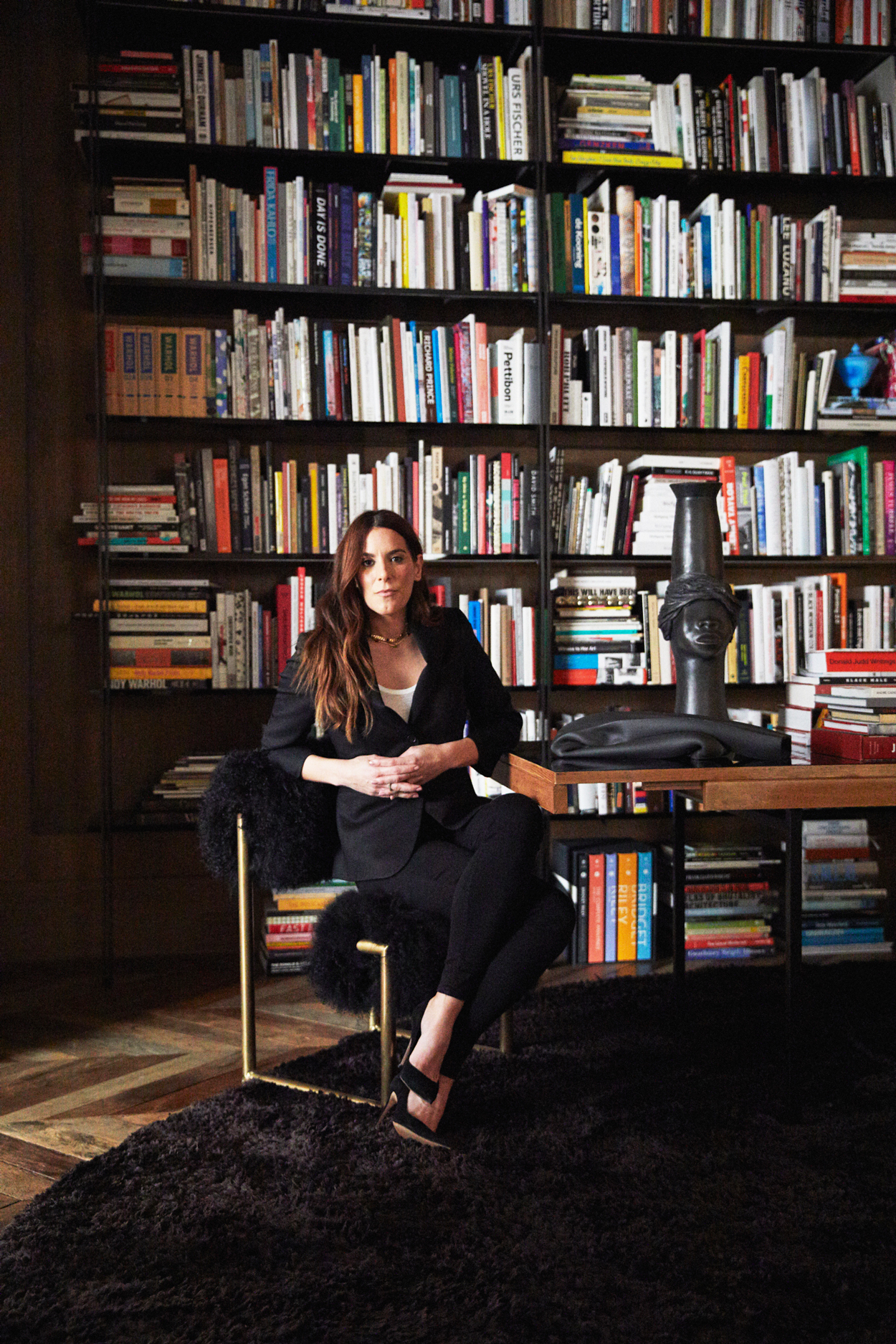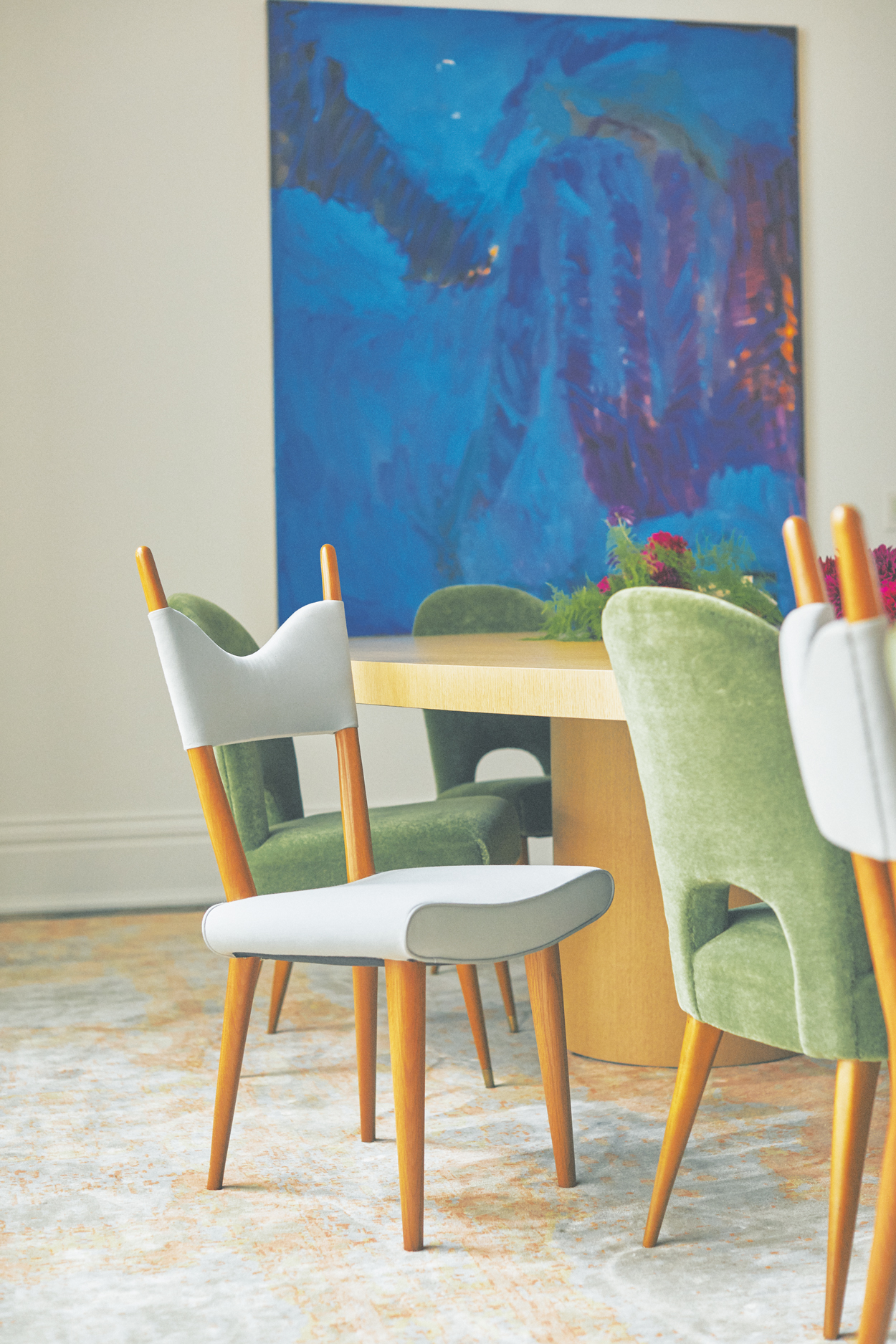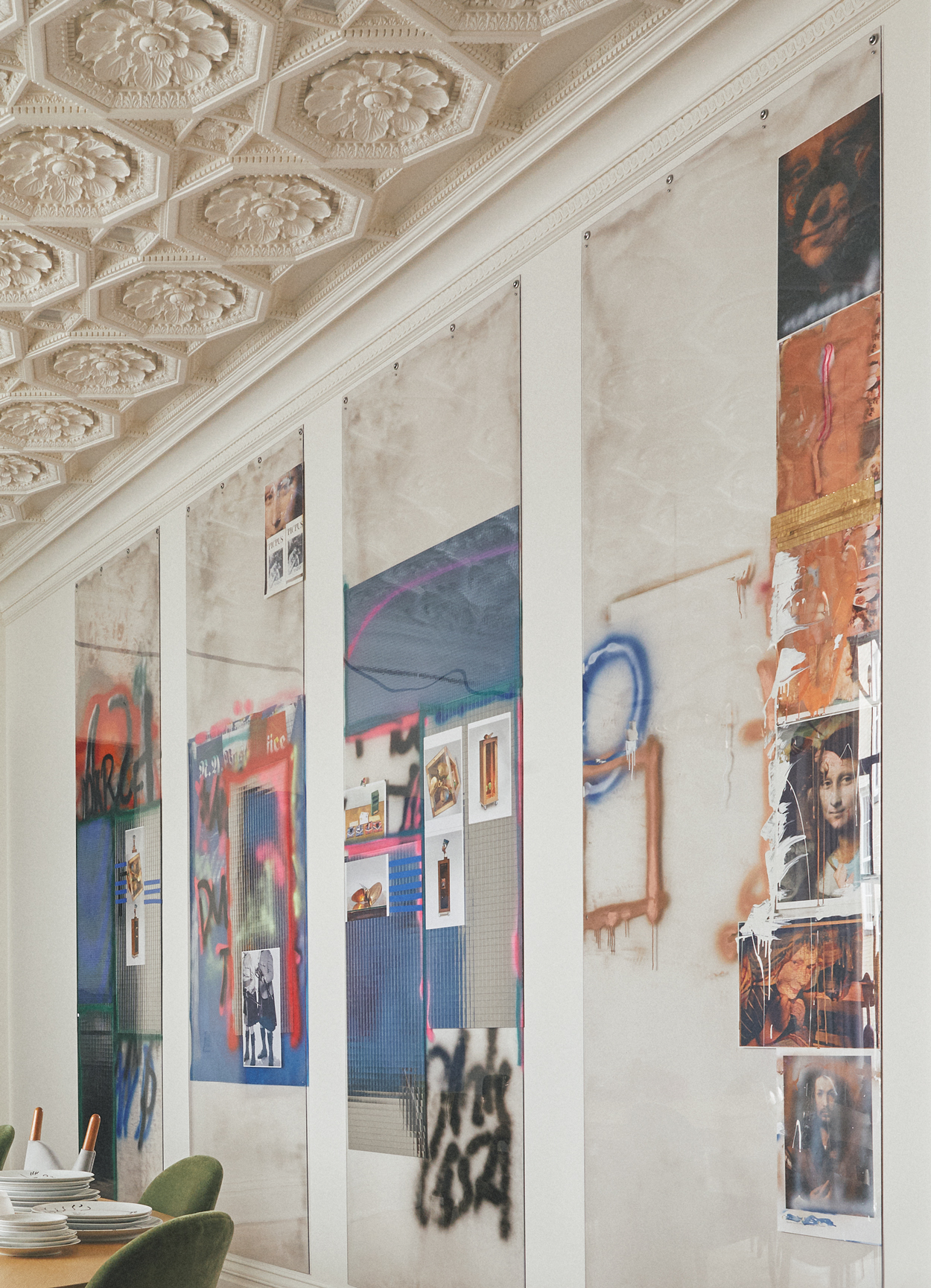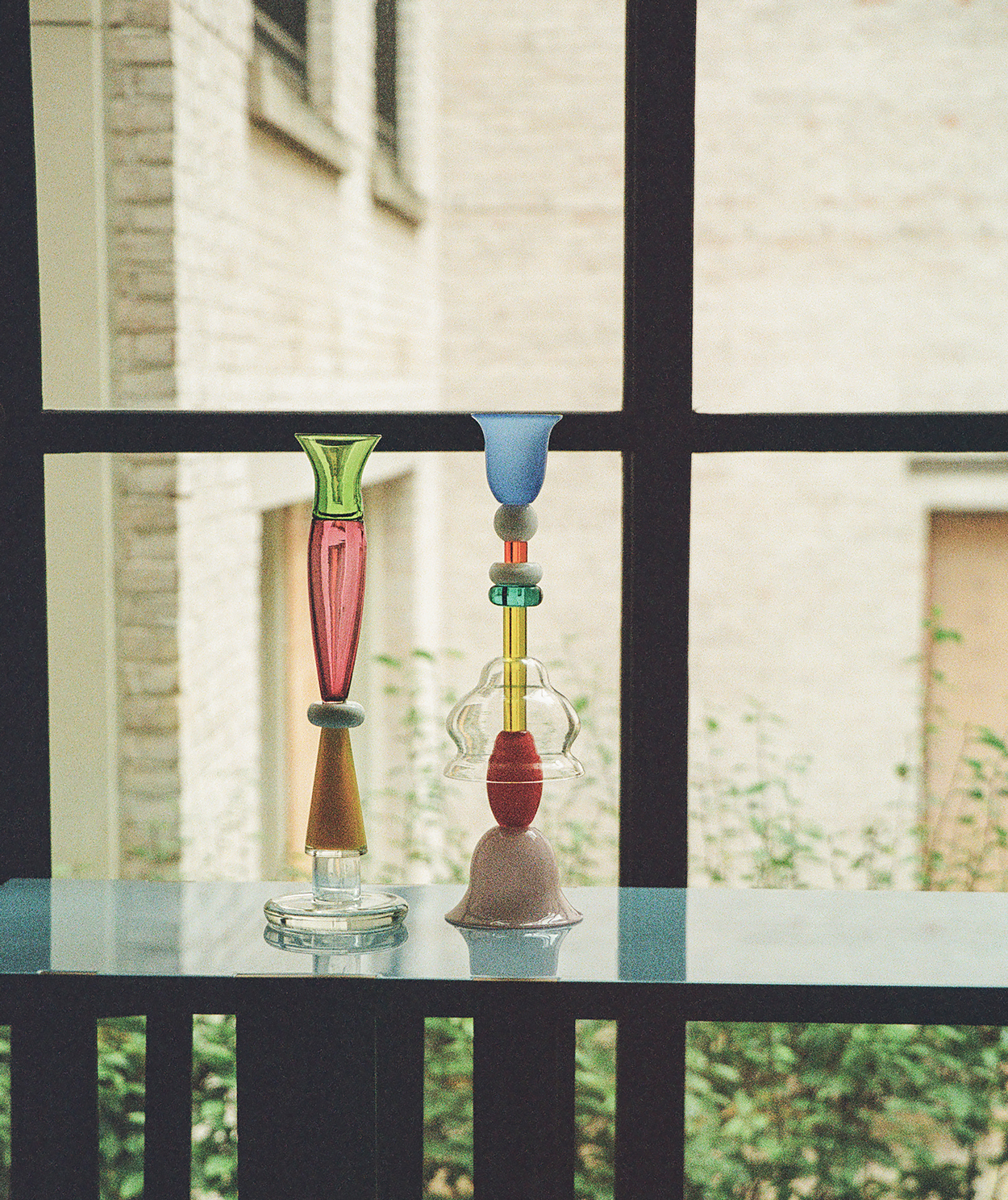A few years ago, when art advisor Eleanor Cayre went looking for a new Manhattan home, an abundance of natural light wasn’t high on her priority list. “Any listing that included a ‘sun-drenched living room’ was not for me,” she recalls with a laugh. The no-daylight policy wasn’t due to any vampiric, out-all-night lifestyle. Cayre was looking for a family home for herself and her husband, the real-estate developer Bobby Cayre, their three teenage sons, and their nine-year-old daughter. The preference had to do with the mercurial creatures that filled their rooms and covered their walls. “Sunlight takes a toll on artwork,” she insists. “Sunlight is overrated, anyway.” This new home was finally going to give Cayre the chance to allow her wildly experimental art collection to take center stage.
The New York Art Advisor Curating the Boldest Family Dinners in Town
Eleanor Cayre doesn’t hesitate to break bread in a room filled with daring contemporary art and design.
Eleanor Cayre doesn’t hesitate to break bread in a room filled with daring contemporary art and design.
Photographs by JONATHAN HÖKKLO December 09, 2019

The native New Yorker is no mere hobbyist when it comes to contemporary art. Since 2007 she’s made a career out of navigating the knotty inroads of top-tier collecting and has become one of the go-to advisers in the city. Cayre Art Group serves an elite clientele with the money to secure museum-quality pieces. But it’s not the market that drives Cayre’s ambitions, it’s her eye—specifically the desire to locate artists whose work addresses the anxieties and impulses of the present moment.
“In many ways, I’m counter-market, counter-trend,” she explains. “I’d rather an exceptional work by an unknown artist than a ho-hum work by a famous one. A shopping list of names isn’t how you build a smart collection.” Cayre’s focus on the here and now was evident in 2008 with an off-site show she produced during Miami Beach Art Basel, for which she enlisted curator Shamim Momin and artist Nate Lowman. Cayre’s husband’s family had a building under construction in midtown Miami that Cayre and her co-conspirators transformed for a rambling, phantasmagorical group show of young artists, many before their names could be found in Christie’s auction catalogs—Lutz Bacher, Haim Steinbach, Terence Koh, Ryan McGinley, Adam McEwen, Rita Ackermann, Sterling Ruby, Jonah Freeman and Justin Lowe. The show proved to be a snapshot of the vital art being made far from the fair’s convention hall. “A lot of the job of advising has nothing to do with buying work,” Cayre says.
“Sometimes it involves telling an overeager collector to refrain from buying and explaining why a piece doesn’t work within a collection. I help steer clients toward becoming donors and board members of institutions. I want them to be part of the art community.” Cayre practices what she preaches. She serves as a principal board member at two scrappy, beloved New York institutions, SculptureCenter in Queens, and Artists Space in downtown Manhattan. (Cayre played a key role in finding the latter’s new TriBeCa digs, which open in December.)
“I collect deep,” Cayre says about her personal collecting ethos. “Once I buy an artist, I stay with them through their career. My clients have the showpieces. I gravitate to more experimental work. I want my collection to tell the story of my generation.” That generational bend is on breathtaking display inside the Upper East Side townhouse the family bought in 2012 (they moved in four years later, the week of the presidential election and the opening of Wade Guyton’s “New York Times Paintings” gallery show. Their five-floor townhouse was built in 1879, its limestone façade renovated in the style of Regency Revival in 1920. But when the Cayres took ownership, the interior had a bad case of the 1970s, with chopped-up floors and wall-to-wall carpeting. They went to work returning the house to its original glory, installing an elegant central staircase and wide-plank herringbone floors. “I spend all of my time in art galleries,” Cayre says. “I don’t want to live in one.” Nevertheless, it’s the art that rules the roost. Upon entering, just beyond the downstairs foyer, a Rachel Harrison sculpture stands sentinel, with its air-conditioner base morphing into a multicolored polystyrene form. At the foot of the stairs gurgles one of Pierre Huyghe’s famously hard-to-maintain aquarium works. Inside the tank’s murky water, horseshoe crabs zip around the black sand floor like vacuum heads, and a thick black electrical cord extends from the sculpture’s base to a nearby outlet. “We can’t charge our phones down here,” Cayre admits, “because the water filter sucks up too much power.”

When Cayre originally started collecting, her first purchases were abstract paintings. “The problem was, the first time I saw them, I loved them the most. They never grew or challenged me.” Since, she has been drawn to the difficult, the frustrating, the confusing, the kinds of works that take effort, time, and a struggle to understand. (Case in point, she recently acquired a first-edition “Female Figure” by Jordan Wolfson; this nightmarish, dancing robot could never be accused of matching a sofa.)
In this new home, Cayre regularly plays host to her extended family, and that is why the second-floor dining room is, for her, the heart of the house. Cayre grew up in Midwood, Brooklyn, a 15-minute walk from the Coney Island beach. She is Egyptian on one side, Syrian on the other. While her father manufactured children’s clothes, Cayre’s love of art bloomed early through her mother, Irene Mamiye, an artist who works in new media. (Creativity runs in the family, as one of Cayre’s younger four siblings is fashion designer Rosie Assoulin.) Cayre met her future husband at 15, having a crush on Bobby for a year before summoning the courage to write her phone number on his hand. The high-school sweethearts married in 1999. Every Friday, rain or shine, important-art-events-be-damned, the Cayres observe Shabbat in the dining room over a feast of Middle-Eastern Jewish food. “I have four siblings, and so does my husband,” she says. “And that doesn’t count all of our cousins. It’s like Thanksgiving every Friday night in here.” A big family means a big table. Cayre revered a 1940s Royère coffee table shaped like a kidney bean, and decided to use it as inspiration for her own elongated biomorphic, custom-made table in white oak. Twenty chairs, a mix of Jean Royère and Jules Leleu, surround the table, the seats upholstered in gray silk and green mohair (kids sit on green because the mohair is easier to clean). Cayre always harbored an affection for the ceilings in New York’s Natural History Museum and had its flower rosette pattern reproduced in plaster for the dining-room ceiling. From it hangs an enormous bronze scribble of a chandelier by Frederik Molenschot, studded with LED lights. To add to the playfulness, a glass table stands by the windows holding festal Memphis Group vases by Ettore Sottsass and Marco Zanini.

One might think the room devoted to family would be spared the full thrust of Cayre’s audacious and unapologetic art. “I like to blow my family’s mind,” she says. The interior wall across from the windows is devoted to a rambunctious quadriptych by German artist Isa Genzken. The plastic panels contain loose collages of graffitied and found images, from Nefertiti to Mona Lisa, as well as squalls of paint and bright reflective paper. When candles are lit at the table, their reflections glimmer warmly in Genzken’s plastic. At the far end of the room blares an aggressive blue abstract painting by German artist Michael Krebber. On either side of the windows hang drawings somberly spelling out AIDS, Robert Indiana–style, in the colors of various national flags, by the art group General Idea. Admittedly not every member of Cayre’s large family is a contemporary-art convert. Still, she has managed to convey a sense of its spiritual and cultural importance. “Wherever my kids are in the world,” she says, “I want them to feel at home in synagogues and museums.”
In the past decade, there has been a tendency for the world’s top art collectors to open their own private museums. When asked if Cayre would ever do the same, she demurs. But what about Peggy Guggenheim, who collected the radical art of her time? Cayre is quiet for a moment, as if she’s considering her own version of a Peggy Guggenheim Collection. But she has a different ambition in mind. “You know, I bought the rights to one of Peggy Guggenheim’s biographies,” she says. “I’ve been wanting to make a film about her life for years.”
